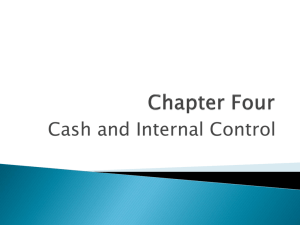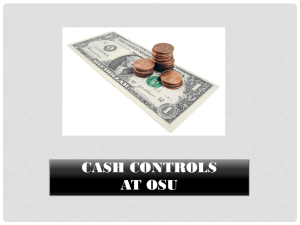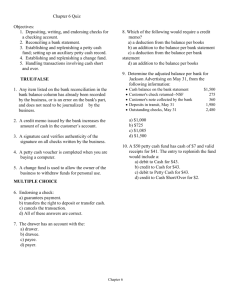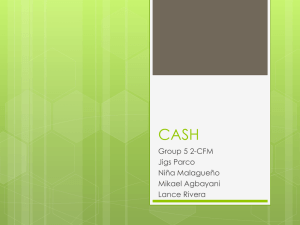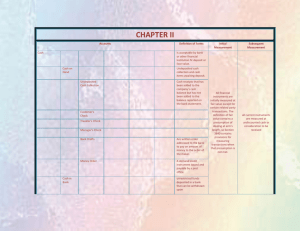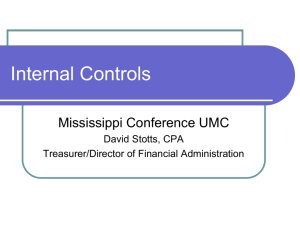1439037752_295888
advertisement
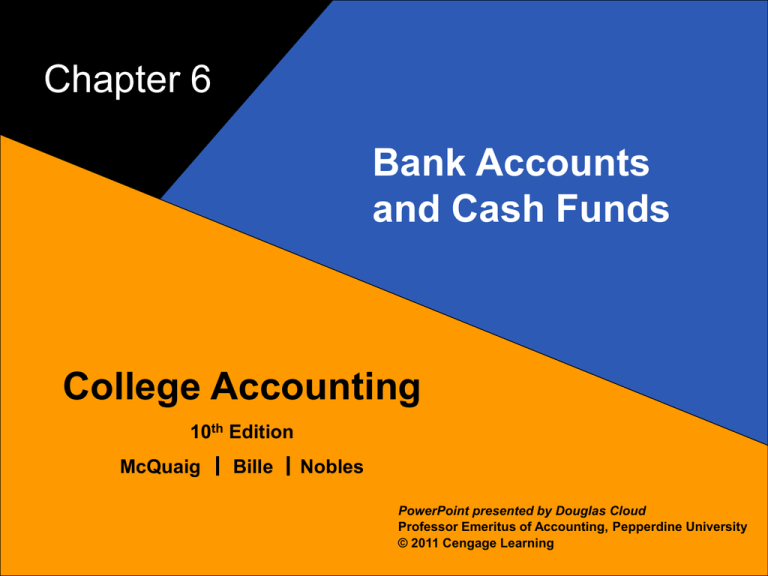
Chapter 6 Bank Accounts and Cash Funds 1 College Accounting 10th Edition McQuaig McQuaig Bille Bille Nobles PowerPoint presented by Douglas Cloud Professor Emeritus of Accounting, Pepperdine University 6–1 © 2011 Cengage Learning Internal Control Internal control is the system of policies and procedures that is designed to: 1. Protect assets against fraud and waste. 2. Provide for accurate accounting data. 3. Promote efficient operation. 4. Encourage adherence to management policies. 6–2 Managing Cash Receipts Maintain separation between cash handling and cash recording. Designate someone other than the bookkeeper to open mail. Make a record of cash received. Endorse checks immediately upon receipt with the stamp, “For Deposit Only.” Deposit cash daily. Journalize cash receipts as soon as possible, preferably by someone different than the person who first received the cash. Post cash receipts to the Accounts Receivable account as soon as possible. 6–3 Managing Cash Payments Make certain that all checks are prenumbered. Make sure that all cash payments are made by check (with the exception of petty cash). Keep check supplies under lock. Assign someone different from the signer of the checks to prepare the checks. Keep petty cash under lock with access limited to one person other than the bookkeeper. Appoint someone other than the person preparing checks to prepare the bank reconciliation. 6–4 Using a Checking Account When a person opens a bank account, that person fills out a signature card for the bank’s files. The bank provides printed deposit slips on which customers record the amount of coins and currency they are depositing and list each individual check being deposited. The ABA (American Bankers Association) number is the small series of numbers located in the upper right corner of a check. 6–5 MICR and Substitute Checks The bank prints the amount of each deposited check on the lower right side of the check in a distinctive script called MICR, which stands for magnetic ink character recognition. The Check Clearing for the 21st Century Act (or Check 21 Act) allows banks to create a two-sided digital version of the original check, called a substitute check. 6–6 Automated Teller Machines Deposits withdrawals, and transfers can be made at all hours at bank with ATMs (automated teller machines). In addition to deposits and withdrawals, a customer may transfer amounts from one account to another (e.g., from savings to checking) as well as check the balance of their accounts. 6–7 Electronic Funds Transfers A transfer of funds initiated through an electronic terminal is an Electronic Funds Transfer (EFT). There is no paper document, such as a check or deposit slip. The monthly bank statement will list the EFT deposits and payments. 6–8 Endorsements The endorsement (1) transfers title to the money and (2) authorizes the payment of the check. 6–9 Writing Checks The party who writes the check is called the drawer. The party to whom payment is to be made is the payee. The information recorded on the check stub is the basis for the journal entry. Checks should be written carefully so that no one can successfully alter them. Canceled checks are checks that have been paid or cleared by the bank. 6–10 Bank Statements The bank prepares the bank statement, which is created from the bank’s viewpoint. The following legends are found on bank statements: CM (credit memo): Increases in or credits to the account. DM (debit memo): Decreases in or debits to the account. OD (overdraft): The withdrawal of more than the cash balance in the account. EC (error correction): Correction of errors made by the bank. 6–11 Bank Statements The canceled checks (checks that have been paid or cleared by the bank) are listed on the bank statement. They are called canceled checks because they are canceled by a stamp on the back, indicating that they have been paid. 6–12 Recording Deposits or Withdrawals 6–13 Need for Reconciling Bank Balance and Ledger Balance Since the bank statement balance and the ledger balance of cash are not equal, a business prepares a bank reconciliation. The person performing the bank reconciliation will be making sure— 1) the dollar amount of each check has not been altered, 2) all of the charges, checks and electronic transfers belong to the company, and 3) deposits are made in a timely way. 6–14 Differences Between the Bank Statement Balance and the Customer’s Cash Balance Deposits in transit. A deposit made after the bank statement was issued. Outstanding checks. Checks that have been written by the company but not yet received for payment by the time the bank sends out its statements. Collections. Money collected by the bank for the customer. Interest income. Interest earned for keeping cash in the bank account. NSF (not sufficient funds) check. A deposited check that the bank cannot process because the check writer’s account does not contain enough money. Service charge. A bank charge for services rendered by the bank. Errors. Mistakes made by the customer or the bank. 6–15 Steps in Reconciling the Bank Statement Step 1. Canceled Checks a. Compare the amount of each canceled check with the bank statement and note any differences. b. In the checkbook beside the check number, list the date of the bank statement. Step 2. Deposits a. Compare the deposits in transit listed on last month’s bank reconciliation with the deposits shown on the bank statement. b. Compare the remaining deposits listed on this month’s bank statement with deposits written in the company’s accounting records. 6–16 Step 3. Outstanding Checks a. Arrange the canceled checks in order by check number. b. Look over the list of outstanding checks left over from last month’s bank reconciliation, and note the checks that have not been returned or cleared. c. For each canceled check, compare the amount recorded in MICR numbers with the amount recorded in the checkbook. d. Review the endorsements on the backs of the checks to verify that money has been sent to the correct payee. Step 4. Bank Memoranda Trace the credit memos and debit memos to the journal. If the memos have not been recorded, make separate entries for them. 6–17 Required Journal Entries 6–18 After the entries have been posted, the T account for Cash looks like this: The balance in the T account is now equal to both the adjusted bank statement balance and the adjusted ledger balance of Cash. 6–19 Form of Bank Reconciliation 6–20 Establishing the Petty Cash Fund To write a check for a small amount is not economically practical. For many businesses the cost of writing each check is more than $10. A business keeps a cash fund for petty (or small) items. This cash fund is known as the Petty Cash Fund. A business will set the maximum amount of payment from the fund before a check is required. 6–21 Roland’s Delivery Service decides to establish a Petty Cash Fund of $100, and put it under the control of the assistant. A check is written for $100 to establish the fund. 6–22 T accounts for the entry look like this: Petty Cash Fund is an asset; therefore, it is listed on the balance sheet immediately after Cash. Once the fund is created, it is not debited again unless the original amount is not large enough to handle the necessary transactions. 6–23 Payments from the Petty Cash Fund A petty cash voucher must be used to account for every payment from the fund. 6–24 Petty Cash Payments Record Some businesses prefer to have a written record on one sheet of paper, so they keep a petty cash payments record. Petty cash vouchers and the accounts that are to be charged are listed as well as the purpose of the expenditure. 6–25 Establishing the Change Fund Like the Petty Cash Fund account, Change Fund is debited only once: when it is established. The Change Fund account is an asset. It is recorded in the balance sheet immediately below Cash, unless Petty Cash Fund is larger. 6–26 Depositing Cash At the end of each business day, Roland’s Delivery Services’ accountant deposits the cash taken in during September 1 ($1,575) but holds back the amount of the Change Fund ($150). On September 9, the cash count is $1,672. So, the accountant deposits $1,522 ($1,672 – $150). Cash Short and Over Because mistakes happen, accounting records must be set up to cope with the situation. If after removing the Change Fund, the day’s receipts are less than the register reading, then a cash shortage exists. When the day’s receipts are greater than the register reading, a cash overage exists. 6–28 On September 14, Roland’s Delivery Service has a cash count of $1,663, while the cash register tape totals $1,515. There is $150 in the Change Fund. Step 1. Remove the $150 in the Change Fund. Step 2 Deposit $1,513 in the bank ($1,663 – $150). Step 3 Record the cash shortage of $2 as part of the journal entry to record income. 6–29 On September 15, Roland’s Delivery Service has a cash count of $1,732, and the cash register tape totals $1,578. The Change Fund has $150, so the service has a $4 cash overage. At the end of the fiscal period, if Cash Short and Over has a debit balance (or net shortage), the accountant classifies it as an expense. Miscellaneous Expense is debited and Cash Short and Over is credited. If the account has a credit balance (or net overage), the accountant classifies it as revenue. Cash Short and Over is debited and Miscellaneous Income (an income statement account) is credited. 6–30 The T account would look like this: 6–31
